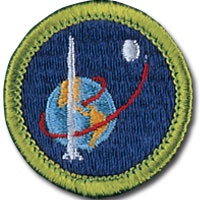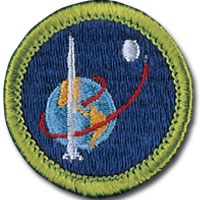Space Exploration
Merit Badge






Space Exploration Merit Badge Supplementals
(created Wed. July 15, 2015 - the day after New Horizons visited Pluto)
(updated Mon. Sep. 26, 2016)
This is an extension of
the Space Exploration Merit Badge page.
The purpose of this page is to 1) list the Space Exploration merit badge requirements and 2) provide information about the answers beyond those provided in the Merit Badge book; please know that only those answers in the book are required to complete the merit badge. The information on this page is shared to provide additional insights into the requirement and to encourage enthusiasm about all that is exciting about the exploring the universe beyond our planet, in person and through unmanned spacecraft.
Was it easy to get our early rockets launched?
Were there any failures, epic or otherwise?
Early U.S. rocket and space launch failures and explosion
https://www.youtube.com/watch?v=13qeX98tAS8
Are there still similar challenges launching rockets today?
Have there been any recent rocket launch failures in the past couple years?
-
-October, 2014:
http://www.cbsnews.com/news/orbital-sciences-rocket-explodes-moments-after-launch/
&
http://www.dailymail.co.uk/news/article-2810128/Ready-liftoff-Nighttime-rocket-launch-International-Space-Station-visible-East-Coast.html -
-June, 2015:
http://www.foxnews.com/science/2015/06/28/spacex-launch-ends-in-failure-rocket-erupts/
What are the two fuel types to use to launch a rocket?
-
-Solid fuel
-
-Liquid fuel
What is NASA’s preferred fuel?
http://www.nasa.gov/topics/technology/hydrogen/hydrogen_fuel_of_choice.html
What is SpaceX’s preferred fuel?
“liquid oxygen and rocket-grade kerosene (RP-1) propellant”
source: http://www.spacex.com/falcon9
Thankfully, when a rocket launch fails, while it is a loss of rocket, payload, and money, people are far enough from the launch to not be injured.
That does not mean that space exploration is completely safe.
The movie “The Right Stuff” is called that for a reason - you still need to be courageous to “strap yourselves in” and fly in space. And, specifically, you need to have the right stuff to be a test pilot; the movie (and the book on which it is based), is actually a tribute to the great Chuck Yeager, who did not get into space, but who had the right stuff to push the envelope further and further in flight.
One write-up about how they made the movie is available at: http://www.wired.com/2014/11/oral-history-of-right-stuff/
And, to remind us that space exploration is a dangerous, we remember the astronauts have “slipped the surly bonds of earth” to “touch the face of God.” (President Ronald Reagan)
-
-Apollo 1’s Gus Grissom, Ed White, and Roger Chaffe
-
-Space Shuttle Challenger’s Michael J. Smith, Dick Scobee, Ronald McNair, Ellison Onizuka, Christa McAuliffe, Gregory Jarvis, and Judith Resnik
-
-Space Shuttle Columbia’s Rick Husband, William C. McCool, Michael P. Anderson, David M. Brown, Kalpana Chawla, Laurel Clark and Iian Ramon.
http://www.kwtx.com/home/headlines/NASA_Remembers17_Astronauts_Who_Lost_Their_Lives.html
While written and spoken for the Challenger astronauts, and while it mentions Apollo 1, the remembrance and blessings apply to Columbia, too:
http://www.americanrhetoric.com/speeches/ronaldreaganchallenger.htm
What are US-based rockets launched, and why are they launched there?
Helpful resources to determine the answer include:
-
-http://www.nasa.gov/centers/kennedy/launchingrockets/sites.html
-
-http://en.wikipedia.org/wiki/List_of_rocket_launch_sites
for the US sites, do pay careful attention to those that are a) inactive, b) private (NM), and c) for NASA, including: -
-Florida - Cape Canaveral
https://en.wikipedia.org/wiki/Cape_Canaveral
http://www.space.com/8811-rockets-launched-florida.html
“The Cape had a big advantage," Starr said over other locations. It was selected for two reasons: the fact that it is relatively near to the equator compared to other U.S. locations, and the fact that it is on the East Coast.
An East Coast location was desirable because any rockets leaving Earth's surface and traveling eastward get a boost from the Earth's spin. A West Coast location would either send rockets over populated areas or have to contend with launching against the direction of the spin.”
http://www.scientificamerican.com/article/space-shuttle-weather-florida/
“And the location that they chose in Florida had a lot to do with the fact that there wasn't anything there. You go there today and you don't see it, but Brevard County in the 1940s was a bunch of orchards and hardly anything else. And this island that they're on [Merritt Island] had good logistics, because there was a navy base and an army base not too far away. But there was no population density whatsoever. It was just a beach, essentially. -
-Virginia - Wallops Island
https://en.wikipedia.org/wiki/Wallops_Flight_Facility -
-California - Vandenberg AFB
https://en.wikipedia.org/wiki/Vandenberg_Air_Force_Base
&
http://space.stackexchange.com/questions/3509/are-there-any-benefits-to-launching-from-vandenberg-afb-instead-of-cape-canavera
“in case of launching into retrograde or polar orbits, Vandenberg is more suitable. ”
On September 22, 2005, we were in Palm Desert, CA, when this rocket launched. We didn’t know what it was at the time, but were impressed by the way it looked in the sky. We later learned it was a rocket launching from Vandeberg AFB, some 300 miles away! The mountain it looks like it may be launching over is Mt. San Jacinto.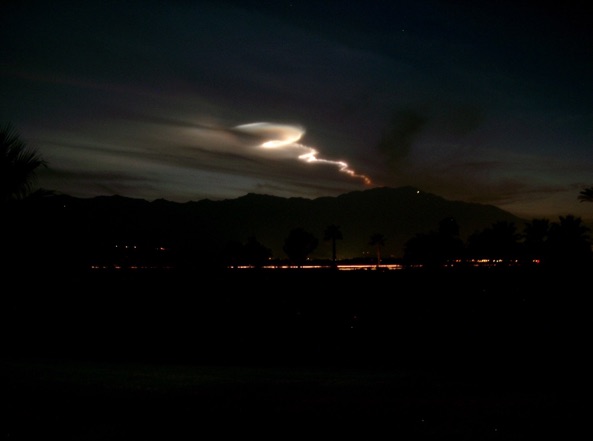
See also:
http://www.spacearchive.info/minotaur-streak.htm
&
https://www.youtube.com/watch?v=ep0BTYeJ6vQ -
-More information about things to consider when you plan a rocket launch:
http://www.spaceplace.nasa.gov/launch-windows/en/
&
http://www.aerospaceweb.org/question/spacecraft/q0080.shtml
How can you keep track of NASA’s rocket launches?
Helpful resources to determine the answer include:
http://www.nasa.gov/launchschedule/
Are there rockets that we can build and launch ourselves?
Yes!
Model Rockets!
Is there a local group who specialized in model rockets?
Yes, the

St. Louis Rocketry Association / http://stlouisrocketry.com
They try to have monthly launches in Buder Park, at 44 & 141.
(if you want to attend, please plan attendance with your parents)
http://stlouisrocketry.com/events
and they plan launches of larger rockets in Ellsberry, toward Clarksville, in the fall.
How high are model rockets allowed to fly?
Helpful resources include:
http://flyrockets.com/index.asp
&
http://flyrockets.com/regulations.asp
How high has a model rocket flown?
Helpful resources include:
http://www.popsci.com/technology/article/2011-10/video-homemade-rocket-covers-121000-feet-92-seconds
What else could you use to explore space?
I wish we had thought of sending an iPhone up on a weather balloon!
Iphone in space - brooklyn space program
https://www.youtube.com/watch?v=OUZBGsLcLvs
PLUTO
♇
Pluto Dazzles in False Color
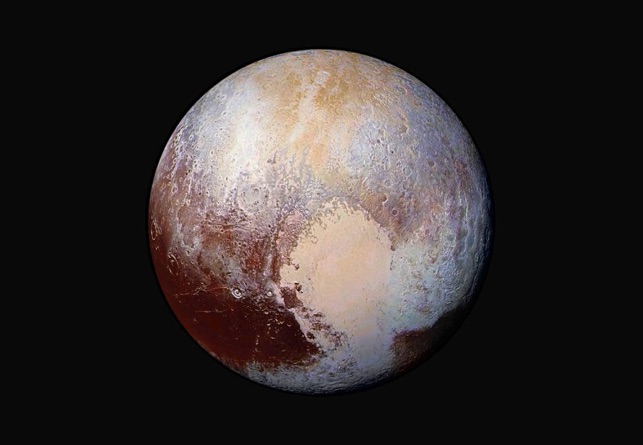
source: http://www.nasa.gov/mission_pages/newhorizons/images/index.html?id=367260
The information about Pluto has grown to be so large that it now has its own page:
http://vanvooren.us/MeritBadges/Space_Exploration_-_Pluto.html
Mars

Mars exploration
Mars is one of the five other planets visible to the naked eye.
Mars, the second planet visited, first successfully landed on first by America’s / NASA’s Mariner 6 (previous landings were unsuccessful by the US and Russia).
References:
http://solarsystem.nasa.gov/missions/profile.cfm?Sort=Target&Target=Mars&Era=Present
&
http://www.nasa.gov/mission_pages/mars/missions/index-past.html
&
https://en.wikipedia.org/wiki/Exploration_of_Mars
Its red color has inspired people through the generations.
From the “Canali” and the first Martians, from Italy, to “The War of the Worlds,” from the U.S.:
“In the 1800s, observatories with larger and larger telescopes were built around the world. In 1877, Giovanni Virginio Schiaparelli (1835-1910), director of the Brera Observatory in Milan, began mapping and naming areas on Mars. He named the Martian "seas" and "continents" (dark and light areas) with names from historic and mythological sources. He saw channels on Mars and called them "canali." Canali means channels, but it was mistranslated into "canals" implying intelligent life on Mars. Because of the then recent completion of the Suez Canal in 1869 (the engineering wonder of the era), the misinterpretation was taken to mean that large-scale artificial structures had been discovered on Mars. The importance of canals for worldwide commerce at that time without a doubt influenced the popular interest in "canals" on Mars.
“In 1894, Percival Lowell, a wealthy astronomer from Boston, made his first observations of Mars from a private observatory that he built in Flagstaff, Arizona (Lowell Observatory). He decided that the canals were real and ultimately mapped hundreds of them. Lowell believed that the straight lines were artificial canals created by intelligent Martians and were built to carry water from the polar caps to the equatorial regions. In 1895, he published his first book on Mars with many illustrations and, over the next two decades, published two more popular books advancing his ideas.
“Lowell's theories influenced the young English writer H.G. Wells, who in 1898 published The War of the Worlds. In this novel, Wells created an invasion of Earth by deadly aliens from Mars and launched a whole new genre of alien science fiction.
“In 1911, "A Princess of Mars", the first of eleven science fiction novels by Edgar Rice Burroughs, was published. Burroughs used Schiaparelli's names for regions on the planet and gave his Martians green skin.
“On Halloween in 1938, Orson Welles and The Mercury Theater on the Air broadcast a radio version of The War of the Worlds. The story, presented as a series of "live" news bulletins, panicked thousands of listeners who believed that America was being attacked by hostile Martians.
“Most experienced astronomers never saw the Martian "canals" and for a good reason. We now know that they never existed! The network of crisscrossing lines covering the surface of Mars was only a product of the human tendency to see patterns, even when patterns do not exist. When looking at a faint group of dark smudges, the eye tends to connect them with straight lines. This has been demonstrated by many laboratory and field experiments.
”
http://www.nasa.gov/audience/forstudents/postsecondary/features/F_Canali_and_First_Martians.html
From this came the Mariner and other programs,
leading to our
Mars Exploration Rovers, ...
http://science.nationalgeographic.com/science/space/space-exploration/mars-exploration-article/
... with their “bouncy ball landings”:
CBSE Videos.com - Rover Landing in Mars
https://www.youtube.com/watch?v=KyktvC7w7Js
and 2012’s MSL / Curiosity,
http://solarsystem.nasa.gov/missions/profile.cfm?Sort=Target&Target=Mars&MCode=MarsSciLab
&
with its awesome landing
The Landing of Curiosity | NASA JPL MSL Mars Rover HD Video
https://www.youtube.com/watch?v=nSGbmtdg5y0&index=18&list=PLldc-1x4_ZVnH7lJVfRpWbdY1T5qCgZLY
Who are some of the people who contributed to space exploration?
Helpful resources to determine the answer include:
Konstantin Tsiolkovsky:
http://www.space.com/19994-konstantin-tsiolkovsky.html
Robert Goddard:
http://www.nasa.gov/centers/goddard/about/history/dr_goddard.html
“Goddard was the first scientist who not only realized the potentialities of missiles and space flight but also contributed directly in bringing them to practical realization. Goddard had a rare talent in both creative science and practical engineering. The dedicated labors of this modest man went largely unrecognized in the United States until the dawn of the Space Age. High honors and wide acclaim, belated but richly deserved, now come to the name of Robert H. Goddard.”
&
http://www.space.com/19944-robert-goddard.html
Werner von Braun:
http://www.space.com/20122-wernher-von-braun.html
Michael Minovitch:
7. Design an inhabited base located within our solar system, such as Titan, asteroids, or other locations that humans might want to explore in person. Make drawings or a model of your base. In your design, consider and plan for the following:
a. Source of energy
b. How it will be constructed
c. Life-support system
d. Purpose and function
-
c.Life-Support system
In order to determine how people at your base will breathe, whether inside the base’s buildings, or while exploring, you should know how we breathe here on earth.
The October, 2014 issue of Astronomy Magazine shares the composition of our own Earth atmosphere:

Do astronauts need space suits, everywhere that is not “on earth”?
-
-Yes
or -
-No
?
This may help you answer:
http://science.howstuffworks.com/space-suit1.htm
One of many thoughts about how we can colonize Mars comes from SpaceX:
http://www.space.com/18596-mars-colony-spacex-elon-musk.html
Final links for Space Exploration information:
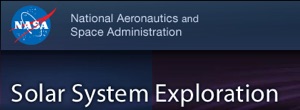
http://solarsystem.nasa.gov/planets/profile.cfm

NASA and many other groups are sharing much good information about images and videos they share via Instagram.
With your parent’s permission, you may want to check out these for yourselves.
Text and images copied and pasted straight from Instagram’s URL to here.
1) https://instagram.com/p/6S1LMZGhye/
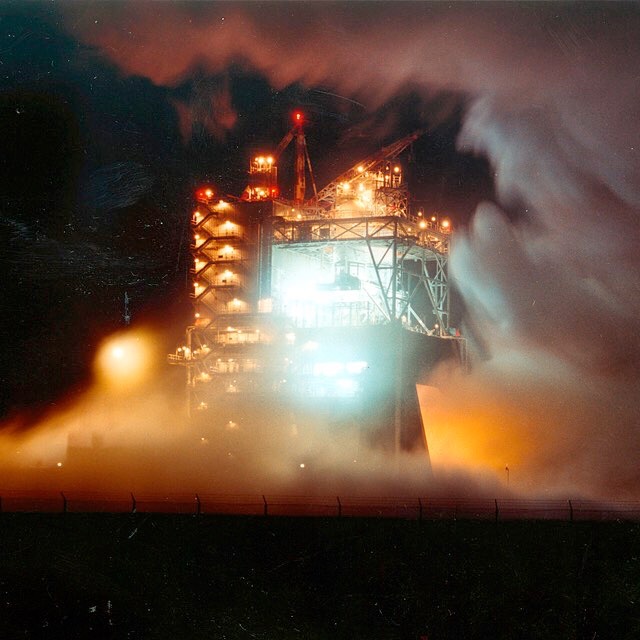
explorenasaPlease join us tomorrow to watch a test fire of the mighty RS-25 engine at John C. Stennis Space Center in Mississippi. The test will be carried live on NASA TV beginning at 3:30 PM CDT / 4:30 EST / 20:30 UTC and will be streamed at www.nasa.gov/nasatv.
Pictured here, the conclusion of a test firing on the A-1 Test Stand -- the same stand conducting tomorrow's test -- illuminating the night sky at @nasastennis. The A-1 is one of three Test Stands at Stennis once used for testing Space Shuttle Main Engines, and now, to test the engines that will power up NASA's Space Launch System heavy lift rocket. On to #Mars!
Credit: NASA / c. 1997
2) https://instagram.com/p/6Qyg2aoaLW/
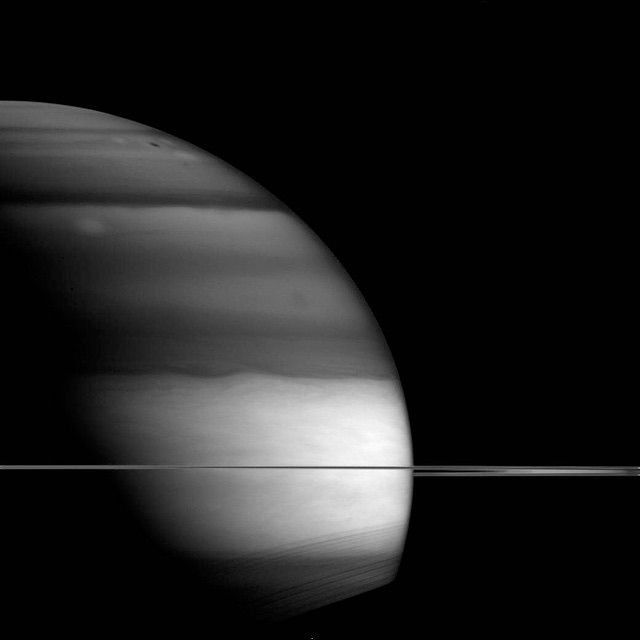
nasaDarkness descending... Saturn's unusual appearance in this picture is a result of the planet being imaged via an infrared filter.
Infrared images can help scientists determine the location of clouds in the planet's atmosphere. In this image, Cassini's wide-angle camera used a filter which is especially sensitive to infrared wavelengths that are absorbed by methane. Methane is not a major component of Saturn's atmosphere, but enough of it is present to make a difference in how much light is reflected by different clouds. The darker areas reveal clouds that are lower in the atmosphere, therefore under more methane. Bright areas on Saturn are higher altitude clouds. Scientists think that these lower-altitude clouds are in regions where "air" is descending while the higher-altitude clouds are in regions where air is rising. Thus, images like this one can help us map the vertical air movements on Saturn.
Credit: NASA/JPL-Caltech/Space Science Institute
#nasa #nasabeyond #cassini #space #solarsystem #saturn #science
3) https://instagram.com/p/6OZmUcIaHX/

"First Veggies Grown, Harvested, and Eaten in Space"
nasaThat’s one small bite for a man, one giant leaf for mankind: Today, astronauts Scott Kelly, Kjell Lindgren and Kimiya Yui of Japan sample the fruits of their labor after harvesting a crop of “Outredgeous” red romaine lettuce from the Veggie plant growth system on the International Space Station. They are the first people to eat food grown in space.
We’re maturing Veggie technology aboard the space station to provide future pioneers with a sustainable food supplement – a critical part of our Journey to Mars. As we move toward long-duration exploration missions farther into the solar system, Veggie will be a resource for crew food growth and consumption. It also could be used by astronauts for recreational gardening activities during deep space missions.
Credit: NASA
4) https://instagram.com/p/6QvcGWlbwe/
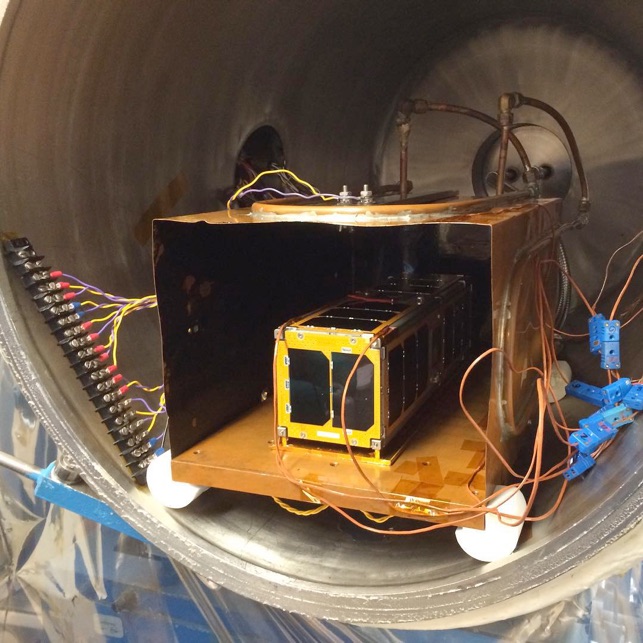
nasajplThis is Radio #CubeSat: New @NASA proving ground for radio science. http://go.nasa.gov/1TrjeHN #CubeSats #LMRST #NASA #JPL #radio #space #science#technology
5) https://instagram.com/p/6QkaThlb7K/
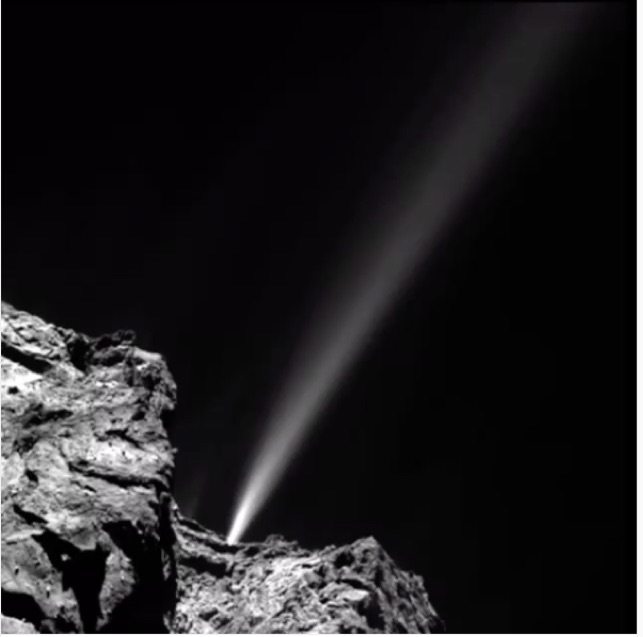
nasajplFabulous flare: The @rosettamission witnessed the most dramatic outburst from #comet #67p to date. More info: http://go.nasa.gov/1gxGKpX #Rosetta #perihelion2015 #osiris #exploration #NASA #ESA #JPL #science #space #NASABeyond
6) https://instagram.com/p/6SPfZaoaPr/
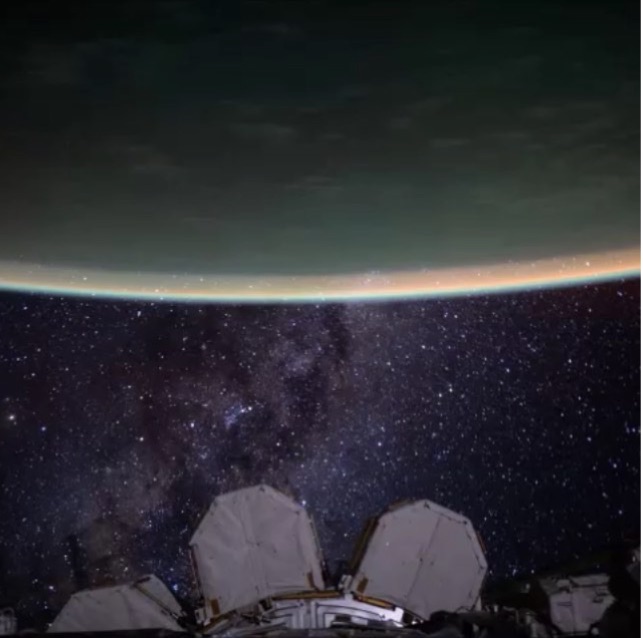
nasaNASA Astronaut Scott Kelly shared this incredible video last night, August 11, showing “our galactic home” with the stars of the Milky Way. Kelly is living and working off the Earth, for the Earth aboard the station for a yearlong mission. Traveling the world more than 220 miles above the Earth, and at 17,500 mph, he circumnavigates the globe more than a dozen times a day conducting research about how the body adapts and changes to living in space for a long duration.
Video credit: NASA
#nasa #spacestation @iss #iss #milkyway #space #stars #nightsky #sky



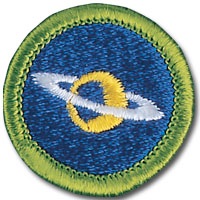
These are all of the links to the Astronomy Merit Badge pages:
Astronomy Merit Badge - Extra “Fun Facts”
Astronomy - Great American Eclipse
Astronomy - Great American Eclipse 2017

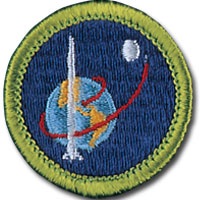
These are all of the links to the Space Exploration Merit Badge pages:
New Horizons - Mission Overview
New Horizons - Pluto Resources


All images were scanned directly from the magazine using the Halo Scanner Mouse - http://shop.halo2cloud.com/collections/computer-and-backup/products/scanner-mouse, which I received as a Christmas present from my mother in 2013.



Regardless your desire to pursue a career in space exploration, it is hoped that you learned enough about exploring space through this merit badge to at least be interested to continuously look up at the sky in awe and wonder, and think about what you may want to explore if you were to go “out there” or were to send a probe “out there.”
If you pursue with enthusiastic interest, that’s great. If you do make a career in the field, GREAT.
May all be better off having completed your Space Exploration Merit Badge than you were before you started.
